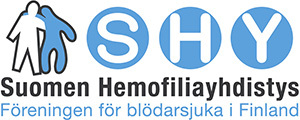Von Willebrand disease (VWD) is the most common hereditary bleeding disorder that occurs in both women and men. Usual symptoms include mucosal and skin bleeding, such as nose bleeds and a tendency to bruise. The disease is named after the Finnish doctor Erik von Willebrand, who published research in 1926 on a family from Åland suffering from severe skin and mucosal bleeding.
In Finland, about 2,000 people have been diagnosed with VWD. In general, up to one percent of the population around the world have been found to have abnormal von Willebrand factor (VWF) levels, but only about a tenth of them have bleeding symptoms that would cause problems.
There are several types and severity levels of VWD and most of the people who have it have mild symptoms. For many, symptoms do not occur in daily life and the bleeding tendency might be found only after an accident or procedure. The key is to find the people with symptoms whose quality of life could be improved by a correct diagnosis and, with it, appropriate treatment. With preparation, unnecessary bleedings due to procedures can also be avoided.
The disease is caused by deficiency or malfunction of VWF. VWF is necessary for the normal action of platelets in the stopping of bleeding. When a blood vessel is damaged, platelets stick to the damaged spot and to each other, forming a plug of platelets. In people with VWD, there is only a small amount of VWF, which glues the platelets to the wall of a blood vessel, or it doesn’t function properly. In blood circulation, VWF also protects factor VIII, which is needed to strengthen the clot. Thus, the final clot forms more slowly and also is broken down more easily in people with VWD.
Inheritance of von Willebrand disease
The disease is inherited autosomally, meaning independent of X or Y sex chromosomes, and is thus not connected to sex. Most forms of VWD are dominantly inherited, and a child can get VWD if one or both parents have the gene mutation causing the disease.
Manifestation of von Willebrand disease
There are three subtypes of Von Willebrand disease (1, 2 and 3). The severity of symptoms depends on the disease type, of which type 1 mild VWD is the most common.
In type 1 VWD, VWF has a normal structure, but too little of it is formed. Many people get significant symptoms only when exposed to situations like accidents, or in connection with medical procedures. Variation in bleeding tendency is typical in type 1 disease, due to fluctuation in the VWF level; for example, in relation to inflammatory disease, use of contraceptive pills or pregnancy. Type 1 VWD symptoms can also become milder as VWF level increases with age.
In moderate type 2 VWD, bleeding tendency can be low in normal circumstances, but without preparing in advance, medical procedures may involve significant bleeding. In type 2 VWD, it is important to try to identify the subtype of the disease, as it has an effect on the treatment decision. In subtype 2B, the amount of platelets is lower than normal, whereas in subtype 2N, there is a normal amount of VWF, but abnormally little coagulation factor VIII. Because of this, subtype 2N VWD may resemble a mild type A haemophilia.
In severe type 3 VWD, VWF is completely missing and, like with severe haemophilia, spontaneous muscle and joint bleeding is typical. Type 3 disease is inherited recessively which means the gene defect is inherited from both parents, who have no or mild symptoms. In Finland, about 30 people have the severe form of disease.
Treatment of von Willebrand disease
Once a diagnosis is confirmed, treatment and regular monitoring at a treatment centre familiar with coagulation disorders is recommended. Proper preparation for procedures requires that VWD status is known already when planning the procedure. One’s own regular treatment facility should be consulted.
Medical treatment is individualised according to the severity of the disease, bleeding to be treated and the procedure to be performed. Medications affecting platelet activity, fever, and pain, such as acetylsalicylic acid (aspirin), as well as anti-inflammatory medicines (ibuprofen, ketoprofen, naproxen etc.) should be avoided. It is also good to remember non-medicinal treatment options. A cold pack can be used for bruises and pressure can be applied to a wound to support stopping of bleeding.
More info on von Willebrand disease can be found in our guide and the guidebook ”Kaikki von Willebrandin taudista”
Duodecim Terveyskirjasto and the Verenvuotaudit — Tietopaketti potilaille guide have been used as text references
